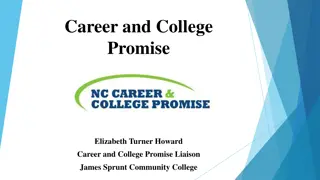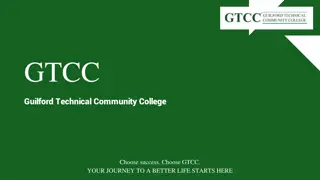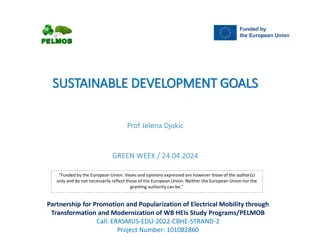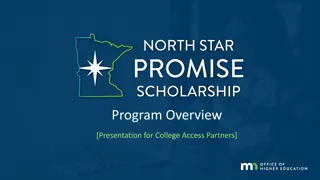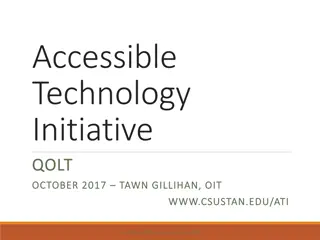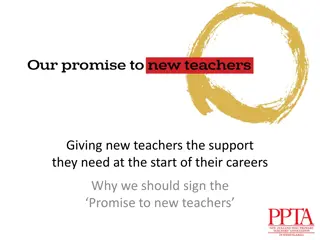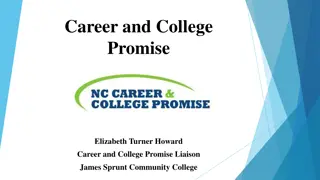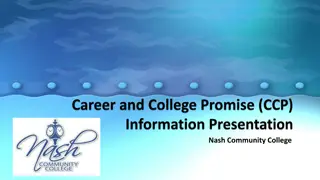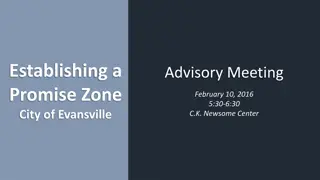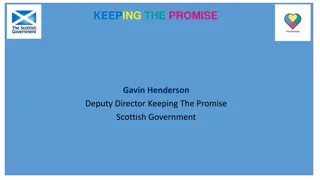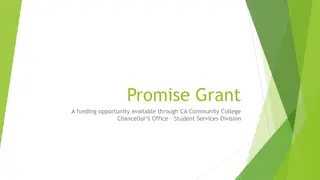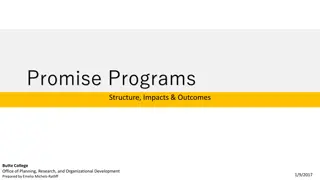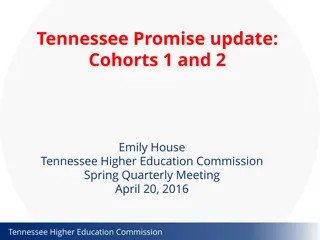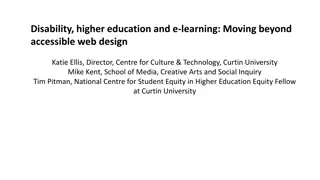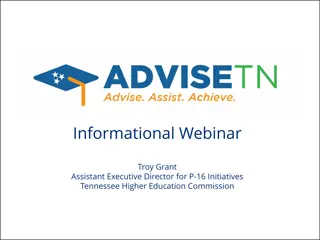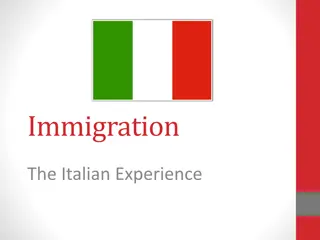America's College Promise Initiative: Making Higher Education Accessible
America's College Promise Initiative aims to provide two years of free community college education to responsible American students. This nation-wide effort is inspired by successful local and state-led programs and focuses on enhancing student responsibility, cutting college costs, and improving educational outcomes. The campaign seeks to create debt-free college options, improve transfer processes, and expand technical training for middle-class jobs.
Download Presentation

Please find below an Image/Link to download the presentation.
The content on the website is provided AS IS for your information and personal use only. It may not be sold, licensed, or shared on other websites without obtaining consent from the author.If you encounter any issues during the download, it is possible that the publisher has removed the file from their server.
You are allowed to download the files provided on this website for personal or commercial use, subject to the condition that they are used lawfully. All files are the property of their respective owners.
The content on the website is provided AS IS for your information and personal use only. It may not be sold, licensed, or shared on other websites without obtaining consent from the author.
E N D
Presentation Transcript
America thrived in the 20thcentury because we made high school free, sent a generation of GI s to college, and trained the best workforce in the world. But in the 21stcentury economy that rewards knowledge like never before, we need to do more. Barack Obama
What is the College Promise?
Americas College Promise is a nation-wide nonpartisan, local, and state-led higher education initiative to make 2 years of a community college education free for responsible American students. The proposal was inspired by bi-partisan efforts in Tennessee, Chicago, Miami, and Kalamazoo where leaders came together to make good on the Promise. The College Promise Campaign will work with leaders in education, business, philanthropy, non-profits, and other sectors to create College Promise programs across the country. The idea is already gaining momentum in places like Oregon, Minnesota, Philadelphia, and Long Beach. College Promise programs are growing!
College Promise Campaign Goals Make 2 years of college as debt-free and universal as high school Enhance student responsibility and cut cost of college for all Americans Help build high-quality community colleges Improve 2-to-4-year institution transfer processes and outcomes Ensure states share responsibility for educating citizens Expand technical training for middle-class jobs Build on local, state, and national programs that support college access, academic persistence, and completion
MAKING COMMUNITY COLLEGE FREE FOR ANYONE WILLING TO WORK FOR IT Work means getting good grades and being serious about getting a degree or certificate. Credits will transfer to a 4-year university or go towards completing vocational certificates and degrees. Local, state, and federal governments work together to pay for this.
HOW DO WE BEGIN?
The campaign will launch a national public awareness campaign that promotes and emphasizes community college completion by: Encouraging community, regional, and state stakeholders to incorporate proven methods that work Leveraging the results of evidence-based research to support investing in the College Promise Implementing outreach, field-building, communications , and publication plans
Long Term.. Over a 3-year period, promoting public policy development at the local and state levels to increase College Promise programs benefiting community college students Implementing a national communications and digital media plan to evaluate students, families, and policy leaders Engage in field-building in 11 states to galvanize local and state leaders to take action Continue to build the campaign to include 20 additional states in the second phase of the campaign Showcase College Promise models and strategies to increase college access and completion
FAQs The following frequently asked questions are provided by Civic Nation. Please visit civic nation.org for more information. What is the College Promise Campaign? In the 21st century, a high school diploma is no longer enough to lead Americans to a good job and decent quality of life. The College Promise Campaign (CPC or the Campaign) is a national, nonpartisan, local and state-led higher education initiative beginning in America s community colleges. The Campaign will build widespread support for a free community college education for all responsible students and broad public understanding that a free community college education is an investment in America s future and a necessary continuation of K-12 education. What is Civic Nation and why is the College Promise Campaign being spearheaded by this organization? Civic nation is a charitable and educational 501(c)(3) organization. Founded in 2015, Civic nation is organized to promote sensible policies to challenges in the areas of federal, state, and local policy. Civic nation educates the public about such policies, about public policy issues arising in these areas, and for related purposes. Further, Civic nation is the legal entity that houses and supports the infrastructure for the College Promise Campaign. no federal or state lobbying is conducted by Civic nation on behalf of the College Promise Campaign
Is the College Promise Campaign a federal or state-led effort? The Campaign is a local and state-led initiative, inspired by Tennessee Governor Bill Haslam s (R) Tennessee Promise program, President Obama s (D) America s College Promise proposal, the more than 59 local College Promise programs spread across the country (e.g., Kalamazoo, Miami, Chicago, Long Beach, Tulsa, etc.), and the America s College Promise Act of 2015 introduced by Senator Baldwin (D-WI) and Congressman Bobby Scott (D-VA). The Campaign is not designed to promote any single approach, but seeks to build a movement around the broader vision of tuition and debt-free college education for the first 2 years, greater state and federal investment in higher education, and the imperative to increase student access and success in higher education. The Campaign assists states, cities, towns, and colleges that want to implement a tuition-and debt-free college education for responsible students by sharing financing strategies, best practices, and complementary efforts to help students succeed, such as mentoring and counseling, reforming developmental education, community service, and other proven strategies. In short, the Campaign collaborates with federal, state, and local leaders across the sectors of education, business, government, philanthropy, students, labor, and non-profits to develop and foster College Promise programs. What if no federal legislation is passed by the United States Congress to support College Promise? In July 2015 the U .S. Senate and the U .S. House of Representatives introduced the America s College Promise Act of 2015. This legislation is currently being considered by Congress and most likely will be the subject of great debate and undergo extensive rewrites, as is typical of most legislative proposals. Amendments and/or new bills could be introduced in future sessions of Congress. This is one reason that the Campaign s goal may be accomplished years down the road. The College Promise Campaign encourages states and communities to introduce their own College Promise legislation. States and communities have the unique opportunity to identify the ways and means to implement College Promise legislation tailored to their particular needs. The Campaign endorses and assists in the development of College Promise proposals at federal, state, and local levels
Can states implement the College Promise Campaign without federal support? Yes. A successful example of a fully state-supported version of College Promise is the Tennessee Promise program. Similarly, states like Oregon, Minnesota, Wyoming, and Oklahoma implemented or are currently initiating College Promise programs. While federal support would significantly bolster any College Promise campaign, states and communities can move ahead without federal support. The College Promise Campaign will study models of promising programs for replication and scaling. The College Promise Campaign welcomes and encourages direct collaboration with states and local communities to initiate tailored College Promise campaigns and specific programs, and to educate policymakers and the public alike on the tremendous value inherent in supporting the College Promise. What does truly bi-partisan mean in the context of this campaign? The College Promise Campaign is non-partisan, meaning that it has no affiliation with or investment in any political party. The Campaign is focused on supporting College Promise programs led by elected and appointed officials from any and all parties. Because the American political landscape is dominated by the Democratic and Republican parties, the term bi-partisan is used to denote collaboration often referred to as working across the aisle on projects that are valued and prioritized by both of the major political parties. The Campaign also welcomes collaboration with elected officials from other political parties like the Tea Party. Universally accessible education at all levels is an American value that is not divided by party lines, and the College Promise Campaign exists in the same spirit. The Campaign is led by a national advisory board and bi-partisan Honorary Chairs, Second Lady of the United States Dr. Jill Biden, arguably community colleges greatest advocate, and Governor Jim Geringer, who initiated a College Promise for the state of Wyoming and earned a distinguished career while serving two terms as Wyoming s governor.
Could the College Promise become another unfunded mandate? The College Promise Campaign is building on a national vision to provide a free community college education for students willing to work hard and complete their certificates and degrees. The Campaign promotes strategies for communities and states to adopt sustainable budget and allocation plans. Experience shows that in difficult economic times, elected officials face unforeseen challenges and unintended consequences, but at the same time, they continue to support policies that have successful outcomes. The Campaign is confident that government leaders and taxpayers will benefit economically, socially, and civically from a better educated society and that they will be more favorably inclined to support the College Promise based on positive results for the long-term prosperity of our nation. Will the College Promise Campaign address education and income inequality? Community colleges already reduce inequality in education and income by serving more than 40% of all undergraduates in the U .S. at more than 1,100 community colleges throughout the nation. However, in the next 10 years, more than 6 out of 10 jobs will require employees to have more than a high school diploma, while today only 40% of U S adults ages 25 64 are adequately prepared for the workforce. The College Promise Campaign s goal is to increase access to higher education through free community college for all responsible students. Because low income students comprise such a large portion of the community college population, the Campaign is designed to increase opportunities for low-income and first generation students, for whom a college education may seem otherwise unattainable. How will the College Promise be applied to Tribal Colleges and Minority- Serving Institutions in general? There are a variety of College Promise programs across the country. The Campaign will identify strategies for communities and states to provide a free community college education for all responsible students, specifically by showcasing details from successful College Promise programs such as the eligibility requirements and evidence-based student outcomes. Where communities and states have already taken leadership to provide a free community college education to their students with or without federal funding, the Campaign will examine their program incentives and funding mechanisms to communicate the details of these models for replication and scaling to other regions, enabling more students to benefit from the College Promise as these models are better understood and adopted.
How and why were the initial host states selected? A goal of the initial phase of the College Promise Campaign is to impact a manageable number of states serving at least half of community college students. As such, the Campaign identified initial host states on the basis of demographic and geographic diversity, size, and variance in state vs. local governance authority. The specific states that were selected have strong local and state leaders who were receptive to the College Promise concept. The Campaign is by no means limited to these states and ultimately intends to reach every state in the country. We strongly encourage individuals from any and all states and communities to join the Campaign. Why aren t 4-year colleges included in the College Promise Campaign? The College Promise Campaign greatly values higher education. At the same time, community and technical colleges are institutions that fill a unique role within American higher education, and serve nearly half of the nation s undergraduates. The Campaign emphasizes that College Promise students are expected to pursue and earn a 2-year college degree, a technical certificate, and/or transfer to a 4-year university bachelor s degree program. Another important reason the Campaign is focused on 2-year colleges is that these institutions serve a large number of first-generation and socioeconomically disadvantaged students. An expected outcome of College Promise programs is to offer opportunities to students who otherwise may not receive them. The Campaign sees community colleges as gateway institutions that admit and support students who in many cases have a tremendous number of obstacles preventing them from pursuing or completing higher education, releasing them back into the workforce where they can make a real living wage with their college credentials, and helping those interested in getting on the track to attaining higher levels of education at an affordable cost. The Campaign underscores that community colleges are the starting point for making the first 2 years of a college education tuition and debt-free. Some College Promise programs have already extended their initiative to 4-year institutions. Communities and states are encouraged to adopt the larger vision if they wish. In short, the College Promise campaign values and supports all education, but identifies community colleges as gateway institutions for helping the greatest number of first-generation and otherwise disadvantaged students enroll and complete their certificates and degrees.
What are the requirements for students to participate in College Promise Programs where available? The College Promise Campaign does not support any one College Promise plan. Across states, cities, and communities, College Promise programs have different eligibility criteria and requirements for students, with respect to maintaining a minimum grade-point average, level of earned income that qualifies students from receiving College Promise financial support, qualifying academic or technical programs, and other criteria unique to a particular community, state or institution. In most College Promise programs, students must be enrolled in an approved academic or technical program at an accredited institution of higher education. What does the College Promise Campaign mean by debt-free education? The vision of the College Promise Campaign is that all students should have the opportunity to complete 2 years of higher education debt free. Specifically, this refers to earning an associate degree, a certification, or transferring to a 4-year baccalaureate program at another institution without having incurred any debt from loans or credit taken out specifically to pay for college tuition, associated fees, basic living expenses, and textbooks. The term free community college has been used colloquially to refer to some College Promise programs. It is important to understand that the goal of these programs is to make 2 years of high-quality higher education universally available to all Americans in the same way that elementary and secondary education are American rights; it s that simple. We believe that just as every American is expected to earn a high school diploma, every American should have the opportunity to earn a college credential.
What is the difference between first-dollar and last-dollar College Promise programs? First-dollar and last-dollar programs refer to two distinct methods of distributing funding for College Promise programs. The term first-dollar program, means that College Promise funds are provided to students first, or before any other grant or awarded funding. By contrast, the term last-dollar program means that students would draw upon any available public funding before being awarded College Promise funds. Both models administer funds to eligible students that cover the direct costs of being a student, such as tuition and fees. In a first-dollar program , the amount of College Promise funding awarded to an eligible student does not take into account any additional funding or grants that the student is eligible for, like a federal Pell Grant. Therefore, a first-dollar College Promise program covers the direct costs of being a student, and has the potential to reduce the associated costs that come with being a student, such as transportation, childcare, school materials, and other costs. In a last-dollar program , the amount of College Promise funding awarded to an eligible student takes into account any additional public funding or grants the student is eligible for, like a federal Pell Grant. The total amount of last-dollar College Promise funding a student receives to cover the direct costs of being a student varies depending on other public funding for which the student is eligible. Unlike first-dollar programs, last-dollar programs do not have the potential of reducing the associated costs that come with being a student, such as transportation, childcare, school materials, and other costs. Is the College Promise separate from or related to the federal Pell Grant Program? College Promise programs are entirely separate from the federal Pell Grant Program; however, as described above, different College Promise program designs can be impacted by Pell Grant support. So although Pell Grant Program funding can supplement or displace College Promise funding, the two programs were developed and are administered separately. What is the timeline for the College Promise Campaign? The Campaign is anticipated to run for 3 years. It officially starts on September 9, 2015, and ends on August 31, 2018, though it could run longer depending on the needs of communities and states.
How will progress be tracked and reported? The Campaign will employ several methods for tracking progress, including: State of Free Community College in America Report The Campaign will produce a metrics-based report on the state of free community college across the country that analyzes the depth of support for the issue, intended outcomes, and progress toward the Campaign s goals. This will include an analysis of the following: Current landscape: the number of students receiving the College Promise. Analysis of stakeholder support: elected officials, education leaders, business CEOs, etc. Analysis of forward momentum: communities and state legislatures taking action. Best-practice College Promise models: access and completion outcomes, evidence from independent researchers. Campaign Activity Report Every 6 months, the Campaign will track and measure the success of its ongoing activities, maintaining qualitative and quantitative reports on various metrics (e.g., engaged leaders, roundtables, engaged key constituency, press publications, social media metrics, etc.). What can I do at the local, state, and federal levels to realize the College Promise for all citizens? Talk about the College Promise to everyone you are close to share your passion and explain why the College Promise matters to students, families and the nation, and encourage them to do the same. Meet with, call, and send letters proclaiming your support of the College Promise Campaign to your federal, state, and local elected officials. Talk to business leaders and let them know that your community is full of untapped potential because of socioeconomic barriers, and that offering 2 years of college to everyone will flood the workforce with a greater supply of more diverse and betterqualified workers. Write letters to your local newspaper editors and news producers about the importance of the College Promise and how keeping it could transform your community by offering educational opportunity to those who otherwise may not be able to access it. Sign up at www.HeadsUpAmerica.us to participate in the Campaign s awareness and outreach effort.
Visit www.CollegePromiseCampaign.org to learn more and stay engaged with the Campaign. Follow news and local developments about College Promise campaigns and share the information through social media networks such as Facebook, Twitter, Instagram, and LinkedIn. Follow the Campaign at #Headsupamerica. Who can I contact for more information? College Promise Campaign 1747 Pennsylvania Ave., N W, Suite 230, Washington, DC, 20006 Collegepromise@civicnation.org Visit www.CollegePromiseCampaign.org and www.HeadsUpAmerica.us to learn more about the College Promise Campaign and for contact information to join the movement!



